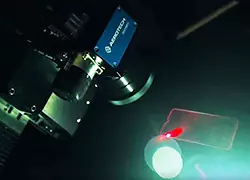Galvo Laser Scan Heads | How They Work and What They Do
Galvo Laser Scan Heads In the world of precision laser material processing, speed and accuracy drive innovation and productivity. The ability to...
Work with our team to determine which products or systems are the best fit for your application.
Some Aerotech products are available for immediate order in North America through our partner Motion Plus.

A case study examining display production that optimizes quality and throughput – and lower total cost.
A precision lift stage is an essential piece of equipment in any environment demanding exact vertical alignment and repeatable positioning. These sophisticated devices are engineered to move heavy or delicate payloads with sub-micron accuracy, solving complex challenges related to height adjustment in three-dimensional space. Their core function is to facilitate controlled movement along the Z-axis, making them a specialized and critical version of linear motion control. To understand the broader mechanical family these stages belong to, a comprehensive understanding of the vertical motion stage is helpful. Achieving optimal results in any high-stakes application hinges on the performance of precision stages like these.
The reliability of a lift stage is often tested under demanding conditions, such as continuous operation or high load bearing. Unlike standard components, a precision lift stage is designed from the ground up to minimize deviations in pitch, roll and yaw during vertical travel, ensuring the payload maintains perfect parallelism. This stability is the key differentiator between a simple mechanical lift and a true precision instrument. By providing this flawless vertical control, these stages enable the most advanced manufacturing, research and inspection processes to achieve previously unattainable levels of accuracy and throughput.
The Z axis vertical stage, also called a lift stage or an elevator stage, is a type of linear stage designed primarily for vertical motion, often used to raise or lower components with precision. It is the designated component for controlling height within a multi-axis system, which is a common requirement in laboratories and automated production lines. Unlike general linear stages, which can move along any linear axis (X, Y or Z), lift stages are optimized specifically for controlled vertical displacement and load support, frequently employing integrated braking mechanisms or counterbalances to safely manage gravity and prevent accidental descent.
The design of their motion guides—be it crossed roller or recirculating elements—must be extremely rigid to support the cantilevered mass of a payload. This stage is a type of vertical lift stage, specifically designed for accurate height adjustments that are necessary for processes like focusing an optical microscope or precisely aligning two vertically separated components before bonding.
Precision lift stages are used to accurately raise or lower components, samples or instruments in applications like microscopy, optics alignment and semiconductor inspection. Their utility extends far into research and industrial automation, including positioning components for laser welding and managing the focus for machine vision cameras They enable repeatable vertical positioning and fine adjustments in height where high accuracy and stability are critical to the process yield. In optics, for example, a lift stage may be used to focus a laser beam onto a workpiece with pinpoint precision, a task requiring extreme mechanical performance and long-term positional stability. Common applications include the use of motorized vertical lift stages for automated processes that require constant, dynamic adjustment without human intervention, leading to faster cycles and higher throughput in manufacturing.
Choose a precision lift stage by evaluating required vertical travel, load capacity and positioning accuracy for your application. These core specifications dictate the fundamental suitability of any model. You must determine the total vertical distance the stage needs to cover and ensure the load capacity comfortably exceeds the mass of the payload plus any dynamic forces. Choosing an appropriate stage for your application involves scrutinizing specifications such as resolution, minimum incremental motion and repeatability, which are crucial for defining the quality of the motion.
You should also consider drive type, speed, stability and compatibility with your control system to ensure reliable, precise motion. For ultra-high precision and dynamic performance, direct-drive or piezo-based actuation systems are preferred, while screw-driven systems offer high force and holding power at the expense of dynamic performance. The mechanical stability, including resistance to vibration and thermal drift, is essential for maintaining position over time.
The choice of a vertical translation stage can significantly impact your project's success, influencing both the feasibility and efficiency of the final process. A well-versed stage manufacturer or motion control supplier can help to guide the selection process, providing critical data on guide geometry and materials.
The main types of precision lift stages include:
Manual lift stages: Adjusted by hand for initial setup or low-frequency use.
Motorized screw-driven stages: Provide automated vertical motion with high force and good resolution.
Motorized direct-drive lift stages: Featuring linear motors for high speed and dynamic performance in vertical indexing.
Piezoelectric lift stages: Offering ultra-fine, small-scale positioning with nanometer resolution for demanding tasks that require ultra-high dynamic performance.
Each type offers a unique balance of speed, force and precision. Variations also exist based on guiding mechanisms, such as cross-roller bearings for excellent stiffness or recirculating bearings for longer travel ranges and lower cost. Understanding the differences between vertical lift stages can aid in making an informed decision that aligns the stage's capabilities with your application's most critical performance metrics.
Ready to dive deeper into the world of precision stages?
Galvo Laser Scan Heads In the world of precision laser material processing, speed and accuracy drive innovation and productivity. The ability to...
What are the applications of laser cutting? Laser cutting is one of the most versatile and widely adopted technologies in modern manufacturing,...